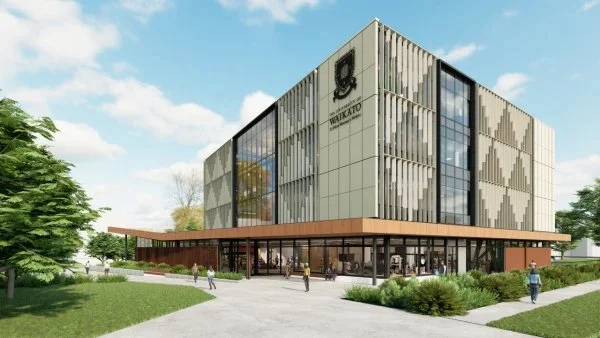New Waikato medical school
By Dan Hutchinson
A new medical school will be established at the University of Waikato as part of the Government’s plan to build a stronger health workforce, Health Minister Simeon Brown and Universities Minister Dr Shane Reti say.
An artist’s impression of the new medical school in Hamilton.
The new school will have a strong focus on primary care and rural health,” Brown says.
The new school will get $82.85 million in Government funding but the university needs to contribute more than $150 million, supported by philanthropic investment
“This is a substantial commitment to education and regional development in the Waikato.
“Today’s decision will enable the University of Waikato to begin construction on new teaching facilities later this year and start planning for clinical placements, while giving more students the opportunity to study medicine in New Zealand.”
MP for Taupō Louise Upston says for communities like Tokoroa, Taupō, and Tūrangi, it means more opportunities for local students to train as doctors and better access to healthcare.
University of Waikato Vice-Chancellor, Professor Neil Quigley, says this is a landmark moment for New Zealand.
“We will be offering a programme that selects and trains doctors in a fundamentally different way and will complement New Zealand’s two existing medical schools.
“It will be designed to produce more graduates who choose to become GPs and who want to work in regional and rural communities.”
Professor Warwick Bagg, Dean of the Faculty of Medical and Health Sciences at the University of Auckland, says the 120 additional doctors will help address the workforce shortage and add to the 360-plus University of Auckland graduate doctors each year.
He says the University of Auckland has 170 medical students at Waikato Hospital and in general practices in the region.
“It will continue to support colleagues and students on clinical placements throughout the upper North Island networks and will continue to run its training programme there.”
The school will offer a graduate-entry programme, providing a flexible new pathway into medicine that helps attract a broader range of students and build a stronger, more diverse workforce.
Minister Brown says the new school builds on the University’s recent additions of nursing, pharmacy, and midwifery programmes.
He says the school adds 120 doctor training places each year, starting in 2028, on top of the 100 additional medical training places that are being added to the University of Auckland and University of Otago programmes.
The University also unveiled the new name of the medical school, the New Zealand Graduate School of Medicine (NZGSM).
It says it is committed to partnering with local communities and plans to have students undertake clinical placements across the country.
University of Waikato Pro Vice-Chancellor Health, Professor Jo Lane, says the NZGSM will “train the doctors New Zealand needs” and address a chronic shortage in primary care.
“Our curriculum will prioritise clinical placements in regional and rural health settings, allowing graduates to experience working with diverse populations while building deep connections in the communities they serve.”
She says the next phase of work is to deepen engagements with rural and regional communities and primary healthcare providers throughout New Zealand to finalise where clinical placements will take place.
Graduate-entry medical programmes require students to already hold a bachelor’s degree. They are the most common model of medical education in Australia and are the predominant model of medical education in Canada and the USA.
This approach has proven to be highly successful in targeting areas with specific need, such as primary care shortages, which is what New Zealand desperately needs, the University of Waikato says in a statement.
Professor Quigley says the University greatly appreciates the groundswell of support from medical professionals and members of the public in recent years that has been so important in making the medical school become a reality.
The four-year programme will begin in 2028, with the first cohort graduating and entering the workforce in 2032.

